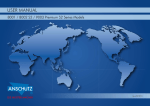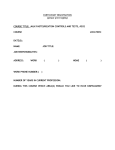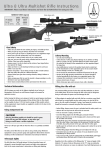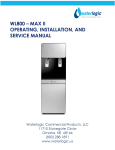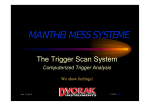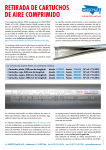Download USER MANUAL - JG ANSCHÜTZ GmbH & Co. KG
Transcript
USER MANUAL 14oo / 15oo / 64 Series Models Issue 03/2015 Contents 1 Components / Terminology................................. 4 11Safety catch............................................................ 13 2 Introduction............................................................. 5 11.1 Engaging the safety catch......................................13 11.2 Releasing the safety catch......................................14 3 Key to Symbols....................................................... 5 12Filling the magazine.......................................... 14 3.1 3.2 General instructions................................................5 Safety instructions...................................................5 13Removing / inserting the bolt.......................... 15 13.1 Removing.............................................................15 13.2 Inserting...............................................................16 4 General handling of firearms.......................... 6 4.1 4.2 4.3 4.4 4.5 4.6 Important basics.....................................................6 Shooting................................................................7 Maintenance..........................................................8 Transport................................................................8 Storage..................................................................8 Hearing and eye protection.....................................8 14Dismantling / assembling the bolt................. 16 14.1 Uncocking the action.............................................16 14.2 Dismantling the bolt..............................................17 15Trigger..................................................................... 18 16Cheek piece........................................................... 21 5 Legal........................................................................... 8 6 Intended use........................................................... 8 16.1 Removing the cheek piece.....................................21 16.2 Adjusting the cheek piece......................................21 7 Liability...................................................................... 9 17Maintenance / cleaning..................................... 21 17.1 17.2 17.3 17.4 8 Assembly and attaching the barrelled action.............................................. 9 9 Barrel fixing........................................................... 11 General...............................................................21 Cleaning the barrel...............................................23 Maintenance intervals...........................................23 Trigger maintenance.............................................24 18Troubleshooting................................................... 24 10Loading / unloading............................................ 11 19Technical data....................................................... 24 10.1 Loading...............................................................11 10.2 Unloading............................................................12 2 20Disposal.................................................................. 25 21Miscellaneous....................................................... 25 22Shooting Performance....................................... 26 23Guarantee.............................................................. 26 3 1 Components / Terminology [1] [13] [2] [3] [4] [12] [5] [11] [6] [7] [10] [9] [8] Fig.1 Overview [1] Cheek piece [8] Magazine [2] Bolt [9] Magazine release lever [3] Bolt handle [10] Trigger [4] Safety catch [11] Trigger guard [5] Receiver [12] Stock [6] Ejection port [13] Buttplate [7] Barrelled action (barrel) 4 2 Introduction 3 Key to Symbols Dear hunting enthusiast, In this user manual, the following symbols are used to distinguish between general information and particularly important information: It's important to be able to rely on the quality of a hunting rifle: 3.1 General instructions for example, exact and ever-consistent shooting performance. With an ANSCHÜTZ barrel and the detailed, well-engineered design of our bolt, you are guaranteed gunsmithing of the finest calibre. Our master builders from the Match Armoury craft hunting rifles drawing on more than 150 years' experience in the manufacture of precision rifles. But of course, tradition isn't everything. You will always be well equipped when you have an absolutely reliable, easy-to-use ANSCHÜTZ rifle. XX is the symbol for an instruction 99 shows the desired result yy is the symbol for a list item )) is the symbol for a possible handling consequence 3.2 Safety instructions You can always rely on a first-class ANSCHÜTZ hunting repeater. Your ANSCHÜTZ rifle will be a reliable companion with unsurpassed accuracy and function at all times. II identifies a safety instruction NOTE! The ANSCHÜTZ team wishes you good hunting! An instruction indicating a specific course of action. CAUTION! Indicates a hazardous situation that can lead to minor physical injury or material damage. WARNING! Indicates a hazardous situation that can lead to serious physical injury or death. 5 4 General handling of firearms II A firearm must only ever be used for its designated purpose. II Firearms owners are responsible for ensuring that their firearm is at no time, and especially when absent, within reach of or accessible to children or other unauthorised persons. Firearms are dangerous objects requiring the utmost care in their storage and use. The following safety and warning instructions must be observed without exception! II Firearms must not be handed over to unauthorised persons. II Only genuine ANSCHÜTZ magazines may be used. NOTE! II The specified capacity of the magazines must not be exceeded. II Modifications to the rifle or the use of non-genuine ANSCHÜTZ magazines and accessories can lead to malfunctions. The firearms legislation of the relevant country is definitive and must be complied with. II Serious or life-threatening injuries and damage can be caused by the use of incorrect ammunition, by contamination in the barrel or by incorrect cartridge components. II Weapons modified in a way that could affect safety must not be used. If a fault or malfunction is detected, the weapon must be unloaded and taken to an authorised gunsmith for repair. 4.1 Important basics NOTE! II In the event of external effects (e.g. corrosion, being dropped, etc.), the weapon must be checked by an authorised gunsmith. The use of firearms while under the influence of drugs, alcohol or medication is not permitted. Vision, dexterity and judgement can all be adversely affected. A good physical and mental constitution is a prerequisite for using a firearm. II A weapon must always be treated with the utmost care and be protected from accidental damage. WARNING! Use only ammunition having a muzzle speed V0 of at least 280 m/s (920 fps). Non-observance of this will result in loss of liability and the guarantee will become void. 6 4.2 Shooting II Any firearm must be treated as if it were loaded. II Never pick up a firearm by the trigger. WARNING! II Shooting galleries must be adequately ventilated. Danger to life and cause of material damage! II Any bullet trap in the shooting gallery must be completely safe and visible. Aiming the rifle at people and objects. hh When the rifle is not in use, keep the muzzle pointing in a safe direction. hh The muzzle of a firearm must never be held in a direction where it can can cause damage or endanger life. II No persons may stand in the vicinity of the target during a shoot. II Firearms should not be used when visibility is poor. II Do not shoot into the air, at hard or smooth surfaces, at water or at targets on the horizon. II Do not shoot at targets if the shot could ricochet or be deflected in a dangerous manner. II To prevent accidents or damage to your rifle, never discharge a shot with the muzzle held under water or up against materials or objects. II Only shoot using the calibre specified on the barrel of the rifle. II Only new, clean, factory-charged ammunition of the calibre permitted for the rifle may be used. II The ammunition must conform to the specifications of the C.I.P. II Only ever load the rifle immediately before use. WARNING! II Life-threatening injuries and material damage can be caused by the use of incorrect ammunition, contamination in the barrel or by incorrect cartridge components. Malfunction when shooting! Shot not discharged after trigger pulled. hh Do not look down into the muzzle. hh Keep the muzzle of the firearm pointing in a safe direction. hh Unload the firearm. hh Remove residues from the barrel. II Only original ANSCHÜTZ parts may be used. II Only genuine ANSCHÜTZ magazines may be used. 7 5 Legal 4.3 Maintenance II Make certain that the weapon is unloaded before and after use, and during maintenance and cleaning work. NOTE! The applicable firearms legislation, regulations and provisions for the relevant country, and also the safety rules of the hunting and sporting organisations must be observed. 4.4 Transport II Firearms may only be transported in an unloaded condition and in locked containers. II Only transport firearms in a clean, dry condition. 4.5 Storage II Firearms that are not in use must be kept in a secure place under lock and key. II Firearms must always be stored in an unloaded and uncocked condition. 6 Intended use II Ammunition must be kept in a separate place under lock and key. It must only be used on shoots and on shooting ranges (for sporting and hunting disciplines) and may only be used by persons who hold the appropriate firearms permit. 4.6 Hearing and eye protection NOTE! NOTE! For your own safety, approved hearing and eye protection should be used when shooting! Shooting without safety equipment can result in damage to your hearing and sight. A firearm must only ever be used for its designated purpose. 8 7 Liability 8 Assembly and attaching the barrelled action ANSCHÜTZ will accept no liability or claims for compensation NOTE! for damage of any kind arising from: yy yy yy yy yy yy yy yy The stock and the barrelled action are packed separately for safety reasons and will have to be assembled. failure to comply with the instructions in this user manual, improper treatment or repair, use of non-original ANSCHÜTZ parts, incorrect handling or care, negligence, removal of the sealing lacquer, unauthorised tampering or transport damage. XX Wipe off any excess oil from the surface of the barrelled action. XX Have the bedding screws [a] to hand. XX Insert the bolt in cocked condition and with released trigger [10]. XX Remove the magazine [8] from the magazine guide. XX Lay the barrelled action [7] in the milled-out channel in the stock [12] (see Fig. 2). CAUTION! Modifications to or tampering with the rifle or its parts are forbidden and may possibly infringe the guarantee conditions. Alterations of this kind can have an adverse effect on the safe use of the product and lead to accidents that endanger life and limb. In such cases the guarantee is automatically void. XX Screw the bedding screws [a] in and tighten alternately and evenly (first tighten the screws lightly, then tighten the front ones and then the back ones (looking towards the muzzle). II The rifle must be examined for any changes each time before use. 9 WARNING! [12] [7] Danger to life! Unintentional discharge as a result of a loaded, unsecured rifle. hh Keep the muzzle of the firearm pointing in a safe direction. hh Engage the safety catch after loading the rifle. NOTE! [a] Settling of the stock wood can occur after the initial assembly of the barrelled action [7]. ANSCHÜTZ therefore recommends loosening the action screws [a] after a time and tightening them again in accordance with Chapter 8. Fig.2 Attaching the barrelled action XX Run the cleaning wick through the barrel from the chamber towards the muzzle several times. NOTE! II The attachment of the barrelled action must be checked each time before shooting to ensure that it is secure. For correct tightening of the action screws [a], ANSCHÜTZ recommends the use of a torque wrench, starting at 2.5 Nm and not to exceed 4.0 Nm. Excessive screw torque may cause damage. WARNING! Danger to life! Unintentional discharge as a result of inattentiveness while engaging the safety catch or as a result of possible malfunctions after securing. hh Even when the safety catch is engaged, the muzzle of a firearm must never be held in a direction where it can can cause damage or endanger life. If you have further questions contact your service center. 10 9 Barrel fixing 10Loading / unloading CAUTION! 10.1 Loading XX Open the breech [2] (pull back in the direction of the arrow to the end stop). The fixing of the receiver and the barrel must not be changed! If a barrel needs to be replaced, this may only be done by ANSCHÜTZ. All liability and guarantees are rendered invalid if the pinning is damaged. [3] [2] Fig.3 Opening the breech CAUTION! Malfunction and danger of injury! Use of non-permitted ammunition and foreign objects. hh Use only the calibre permitted for use with the firearm. 11 10.2 Unloading XX Close the breech [2] (slide up to the stop in the direction of the arrow) and push the bolt handle [3] downwards. XX Open the breech [2] (move the bolt handle 3 upwards counterclockwise and then pull back in the direction of the arrow). [3] [3] [2] [2] Fig.4 Closing the breech Fig.5 Opening the breech 99 The rifle is now ready to shoot (loaded and cocked). NOTE! NOTE! Any cartridge that is still in the chamber will be ejected. Closing the action feeds the cartridge into the barrel. WARNING! Danger to life! Unintentional discharge as a result of a loaded, unsecured rifle. hh Keep the muzzle of the firearm pointing in a safe direction. hh Engage the safety catch after loading the rifle. 12 11Engaging / releasing the safety catch XX Close the breech [2] (slide up to the stop in the direction of the arrow) and push the bolt handle [3] downwards. NOTE! [3] The safety catch can only be engaged/released when the rifle is cocked. The following describes the general procedure "releasing/setting the safety catch". [2] 11.1 Engaging the safety catch XX Push the safety catch [x] to the rear (in the direction of the arrow) (red spot is not visible). Fig.6 Closing the breech XX Pull the trigger [10]. 99 The rifle is unloaded and uncocked. [x] Fig.7 Safety catch "Safe" 99 The rifle is cocked and the safety catch is engaged. 13 12Filling the magazine 11.2 Releasing the safety catch XX Push the safety catch [x] to the front (in the direction of the arrow) (red spot is visible). XX Push the magazine release lever [9] forwards (in the direction of the arrow). CAUTION! Physical damage! After it is unlocked, the magazine can fall out of the magazine guide on its own. hh Hold a hand below the magazine when unlocking it. [x] XX Take the magazine [8] out of the magazine guide (in the direction of the arrow). Fig.8 Safety catch "Ready to Fire" 99 The rifle is cocked and the safety catch is released. [9] Fig.9 Removing the magazine 14 [8] 13Removing / inserting the bolt XX Push the cartridge, base first between cut-outs on the sides, into the magazine [8]. 13.1 Removing WARNING! XX Slide the bolt releasing lever [z] forwards (direction of arrow), pull the trigger [10] and at the same time withdraw the bolt [2] from the receiver [5]. Danger to life! Incorrect calibre in the magazine. hh Only use the calibre specified on the barrel of the rifle. [z] Fig.10 Magazine filled Fig. 11 Releasing lever II Only genuine ANSCHÜTZ magazines may be used. II The specified capacity of the magazines must not be exceeded. [5] [2] II Only cartridges of the calibre specified on the barrel of the rifle may be used. II Only new, clean, factory-charged ammunition of the calibre permitted for the rifle may be used. II The ammunition must conform to the specifications of the C.I.P. XX Push the full magazine [8] into the magazine guide until it engages audibly. 99 The magazine is filled. [10] Fig.12 Removing the bolt 15 14Dismantling / assembling the bolt 13.2 Inserting XX Cock the bolt [2] (see Chapter 14.2). XX Bring the bolt [2] up to the receiver [5] (with the guide slot facing downwards) while pulling the trigger [10] and push the bolt [2] forwards until it engages (direction of arrow). [5] [2] [a] [10] [b] [c] Fig.14 Bolt Fig.13 Inserting the bolt 14.1 Uncocking the bolt 99 The bolt is inserted. NOTE! The bolt [2] can only be pushed into the barrel [7] when it is cocked. a Bolt head b Central part of bolt with bolt handle c Rear part of bolt XX Pull the rear part of the bolt [c] against the spring force out of the detent in the opposite direction to the middle section with the bolt handle [b]. XX Twist the rear part of the bolt [c] against the middle section with the bolt handle [b] until the bolt is uncocked. 16 14.2 Dismantling the bolt XX Remove the firing pin [x] and the interlocking spring [y]. XX Twist the bolt head [a] through approx. 90°. [x] [y] [a] Fig.17 Removing the firing pin and coil spring [b] XX To reassemble, carry out these steps in reverse. NOTE! Fig.15 Dismantling the bolt The bolt head [a] should engage with the middle section with the bolt handle [b], as shown in Fig. 14. XX Pull the bolt head [a] over the interlock on the middle section of the bolt [b]. Fig.16 Pulling off the bolt head 17 15Trigger CAUTION! Physical damage! Damage to the trigger caused by the breech not being open when the trigger is changed. hh Open the breech when changing the trigger. 1 Trigger weight [1] [2] Adjusting the trigger weight by means of trigger weight adjusting screw [3]: yy turn clockwise = trigger weight is increased (+) yy turn anticlockwise = trigger weight is reduced (–) [3] The trigger and first stage weights are mechanically interdependent. Any adjustment always results in a small concurrent change in the trigger or first stage weight. Fig.18 Trigger Key to illustration 1 Trigger blade clamping screw 2 Sear engagement adjusting screw 3 Trigger weight adjusting screw WARNING! Danger to life! Danger to life from loaded firearm. hh Make sure that the rifle is unloaded when carrying out alignment and adjustment procedures. 18 2 Sear engagement If the sear engagement is too long: 2.1 With two-stage trigger There is a short travel from the second stage to the release of the trigger (socalled "pull" or "tug"). XX After cocking and releasing the trigger, turn the sear engagement adjusting screw [2] anti-clockwise in steps (approx. 1/8 turn each time). The sear engagement denotes the travel from the second stage to the release of the trigger. WARNING! XX Repeat the procedure until the second stage is no longer perceptible. Danger to life! XX Then turn back 1/3 turn clockwise. Unintentional discharge as a result of too short a sear engagement or too low a trigger weight. hh Do not set the sear engagement too short. hh Do not set the trigger weight too low. hh Do not subject loaded and unsecured rifles to impact and do not use force to close the breech. 99 The optimum sear engagement is now set. If the sear engagement is too short: There is no longer any second stage. The trigger releases indefinably without a second stage. XX After cocking, turn the sear engagement adjusting screw [2] at least 1/4 turn clockwise, release the trigger and check whether there is a second stage. XX If not, repeat the procedure until there is a perceptible second stage. Adjusting the sear engagement on a two-stage trigger by means of the sear engagement adjusting screw [2]: yy turn anticlockwise = sear engagement is shortened yy turn clockwise = sear engagement is lengthened XX As soon as there is a perceptible second stage, proceed according to the subsection "If the sear engagement is too long" to achieve the optimum sear engagement. Setting the optimum sear engagement: II The rifle must be unloaded. XX Cock the rifle and release the trigger (check whether the trigger releases as desired). 19 3 Trigger malfunctions caused by misadjustment 2.2 Adjusting the optimum sear engagement on a single stage trigger by means of the sear engagement adjusting screw [2]: Proceed as follows in the event of malfunctions caused by a misadjusted trigger: XX The trigger function must be checked after every change. XX Cock the trigger XX Turn sear engagement adjusting screw [2] (second stage) clockwise until the trigger releases. XX When the malfunction has been rectified, check the desired trigger characteristic and adjust it again if necessary. XX From this setting, turn sear engagement adjusting screw [2] approx. 1/3 turn anti-clockwise. The trigger catches the firing pin but does not fire when pulled: WARNING! yy Danger to life! Check whether the safety catch is engaged. The trigger is not catching the firing pin (single stage trigger set too tight): Self-discharge of a shot as a result of too short a sear engagement or too low a trigger weight. hh Do not set the sear engagement too short. hh Do not set the trigger weight too low. hh Do not subject loaded and unsecured rifles to impact and do not use force to close the breech. yy Turn sear engagement adjusting screw [2] anti-clockwise by approx. 1 – 2 turns. Then proceed per Chapter 15, Trigger 2.2. Adjusting the trigger blade XX Release the trigger blade clamping screw [1]. XX Slide the trigger blade along the guide. XX Re-tighten the trigger blade clamping screw [1] hand-tight. NOTE! If the trigger is changed, the bolt [2] must always be removed from the receiver [5] while it is being screwed on. 20 16Cheek piece 17Maintenance / cleaning 16.1 Removing the cheek piece 17.1 General XX Unfasten the clamping screw [x]. WARNING! XX Remove the cheek piece [1] from the holder. Danger to life! XX Fit in reverse order. Danger to life from loaded firearm. hh Ensure that the rifle is unloaded before use or during maintenance and cleaning work. 16.2 Adjusting the cheek piece The cheek piece can be tilted to various positions. The knurled screws [y] and the fixing screws [z] must be released to set to the various positions. XX Unfasten the clamping screw [x]. XX Release the appropriate adjusting screw for the desired tilt position. CAUTION! XX Tilt the cheek piece [1] and retighten the corresponding adjustment screw hand tight. Injury and physical damage! Danger of injury or material damage as a result of not removing oil from the barrel and chamber. hh Each time before shooting, any oil or foreign objects must be removed from the barrel and chamber. XX Retighten the clamping screw [x] hand tight. [1] [y] [z] [x] Fig.19 Cheek piece 21 NOTE! CAUTION! Always look out for any changes or damage that may occur to the rifle. In the event of a change or damage, the rifle must immediately be taken to an authorised gunsmith or sent to ANSCHÜTZ for inspection. After each use of the rifle, apply a thin film of oil to the steel parts and thoroughly clean the barrel. When the rifle is transported from cold to warm rooms, condensation can form on the metal parts and inside the barrel. If this condensation is not quickly dried off, it can possibly lead to surface rust. No other aids (felt plugs, non-approved grease, etc.) should be used for cleaning the barrel. NOTE! The rifle should be protected from dust, sand, moisture, heat and damaging influences. NOTE! To reduce the risk of breaking the stock during transport, ANSCHÜTZ recommends separating the barrelled action from the stock, especially during air travel. NOTE! The rifle case/soft case should be cleaned regularly and any dust and fluff removed. Rifle cases and soft cases should have a smooth, dust-repellent lining. When not in use, the rifle case/soft case should always be left open to allow moisture to escape. Enclosing a desiccant can reduce the moisture content. NOTE! Please clean your rifle – particularly the bolt – after each use, when using a silencer. Please also observe the cleaning instructions provided by your silencer manufacturer! 22 17.3 Maintenance intervals 17.2 Cleaning the barrel NOTE! If the barrel is only slightly dirty, use a plastic brush to clean it. XX Oil the plastic brush lightly and push it through the barrel from the chamber end using a clean cleaning rod. Pay attention to the instructions supplied with the cleaner. Before shooting yy Carefully remove any oil from the rifle. II The de-oiling of the rifle should be carried out at room temperature, as too many residues can be left in the barrel if it is very cold. Fig.20 Plastic brush If the barrel is very dirty, use a bronze brush together with a suitable barrel cleaner. yy NOTE! Fire around 10 shots to re-establish even shot performance (oil shots). After shooting Pay attention to the user instructions for the cleaner! yy yy yy yy yy Fig.21 Bronze brush XX Pull a woollen swab through the barrel several times to dry it. Allow the rifle to warm up to room temperature with the breech and the snow cover opened. Carefully remove condensate from the outside parts. Dismantle the firearm and remove condensate from the individual parts as well. Oil the rifle (including the stock) with a suitable gun oil. Clean the barrel with a plastic brush and gun oil. With new rifles (up to 10,000 shots) at 1,000 shot intervals and then at a min. of 5,000 shot intervals NOTE! yy Clean the barrel from the chamber to the muzzle using a suitable barrel cleaner and a brass brush. II Do not pull the brush backwards and forwards in the barrel. It is essential to re-oil the barrel after using ammonia-containing cleaning agents, to avoid the risk of corrosion. yy 23 Unscrew the brass brush outside the barrel and carefully pull the cleaning rod back through the barrel. yy yy yy 18Troubleshooting Pull the cleaning wicks through the barrel in a dry condition a few times, until the final cleaning wick does not show any appreciable contamination. Wipe the rifle (including the stock) with an oily rag. Take the rifle to a dealer/gunsmith for inspection. WARNING! In the event of malfunctions (e.g. shots not discharged, etc.) the rifle must be unloaded, secured and taken without delay to a specialist dealer / gunsmith or sent to ANSCHÜTZ. 17.4 Trigger maintenance yy Dry the trigger and keep free from dust (the release latches have been greased with long-life grease by Anschütz). yy To avoid gumming, adhesion or soiling of the trigger parts, never wash out the inner parts of the trigger with a spray or oil. II No dirt, solvent residues, grease or unsuitable oils must get into the trigger assembly during maintenance of the rifle. ANSCHÜTZ recommends cleaning the rifle on its side or with the stock pointing upwards, which will prevent any adverse effects on the trigger assembly. 19Technical data Weight 2.4 – 3.9 kg (model-dependent) Overall length 82.6 – 110 cm (model-dependent) Barrel length 35.5 – 65 cm (model-dependent) Rifling 5.5 – 65 cm (model-dependent) Barrelled action length (model-dependent) Version Repeater Calibre .22 l.r., .22 WMR, .17 HMR NOTE! The technical data for similar models can be found at www.anschuetz-sport.com. 24 20Disposal 21Miscellaneous The disposal of the rifle must be carried out and certified by a specialist dealer or gunsmith. Additional information is available on the Internet at www.anschuetz-sport.com. News about this and other products can also be obtained by subscribing to the free-of-charge ANSCHÜTZ Newsletter on the internet. The original group for your rifle at 50 m (cal. .22 l.r., .22 WMR) / 100 m (cal. .17 HMR) is affixed to the CD case. www.anschuetz-sport.com 25 22 Shooting Performance 23 Guarantee The shooting precision of a rifle depends on several factors. One very important factor in this respect is the ammunition. Not every barrel shoots with the same efficiency. Considerable performance differences are apparent with each ammunition type. <<< WARRANT Y >>> 1. Material: This product has been released for sale after the product itself, its materials and individual components have been subjected to strict inspection, or the rifle has demonstrated its durability and function during test shooting. J.G. ANSCHÜTZ GmbH & Co. KG offers a full guarantee covering material and manufacturing faults (excluding broken stocks and springs) for a period of two years, provided that the fault can be shown to have been present at the time of handover of the product. No warranty claims will be accepted by J.G. ANSCHÜTZ GmbH & Co. KG for faults that are the result of improper use or unauthorised repairs. The item will either be repaired or replaced at our discretion. Claims for compensation - put forward for any legal reason whatsoever – are excluded. The target sight and its mount are just as important. Parallax, loose reticle, faulty reticle adjustment and inappropriate mount are the most frequent causes of poor shooting performance. As such, only brand-name telescopic sights and mounts should be used and the ammunition matched to your rifle. 2. Shooting Performance: The purchaser undertakes to inform J.G. ANSCHÜTZ GmbH & Co. KG in writing of any faults detected in shooting performance within one month of purchase with the submission of their own shooting record. J.G. ANSCHÜTZ GmbH & Co. KG reserves the right to transfer the rifle to an independent agency for inspection (DEVA or a national ballistics office). Should such an agency confirm excellent shooting performance, J.G. ANSCHÜTZ GmbH & Co. KG is entitled to charge the purchaser the costs of the rifle inspection. The accepted warranties do not apply to rifle damage resulting from mechanical effects and improper use or care by the purchaser. The warranty is excluded if the rifle has been repaired or modified by unauthorised persons. Likewise, the warranty is cancelled when using reloaded ammunition or ammunition which is not CIP approved. Even ammunition from the same manufacturer and the same batch can, from one production run to another, and from one rifle to another, result in varying shooting performance and hitting accuracy. When the most suitable ammunition, target sights and mount have been selected we can guarantee the excellent shooting performance of our weapons. See warranty card. In the event of a warranty/damage claim please enclose this card, completed and signed by your dealer, with the product. J.G. ANSCHÜTZ GmbH & Co. KG · Jagd- und Sportwaffenfabrik Daimlerstrasse 12 · D-89079 Ulm/Germany · www.anschuetz-sport.com SERIAL-NO.: DATE: THIS ITEM WAS PURCHASED FROM: (Stamp or sales reciept.) 26




































